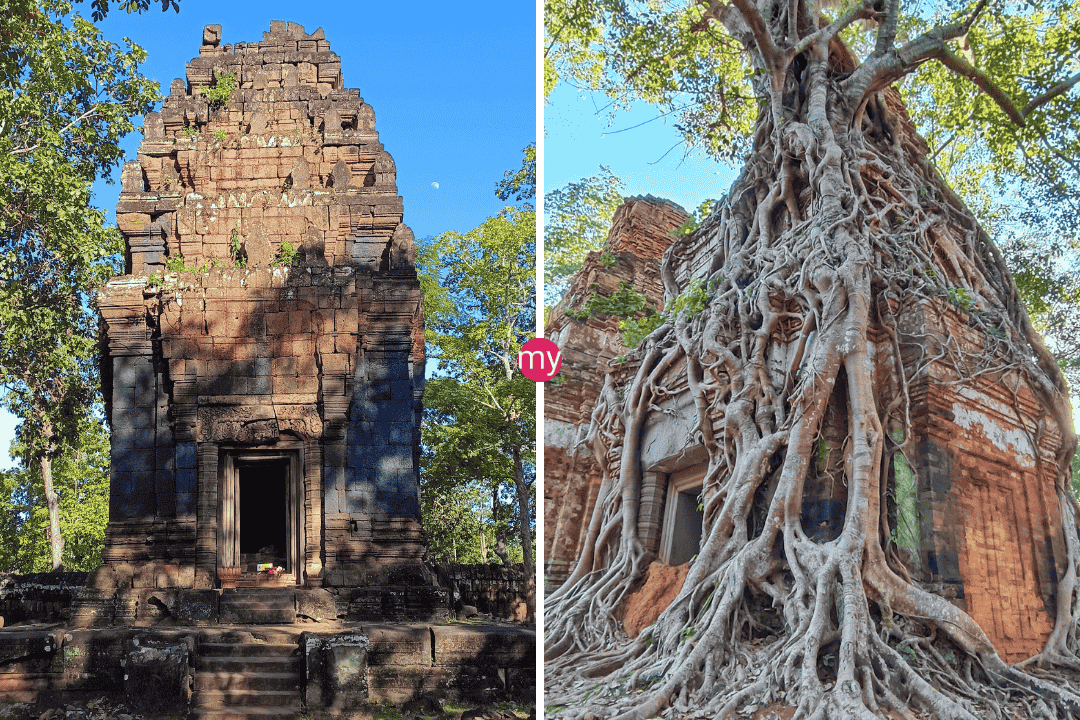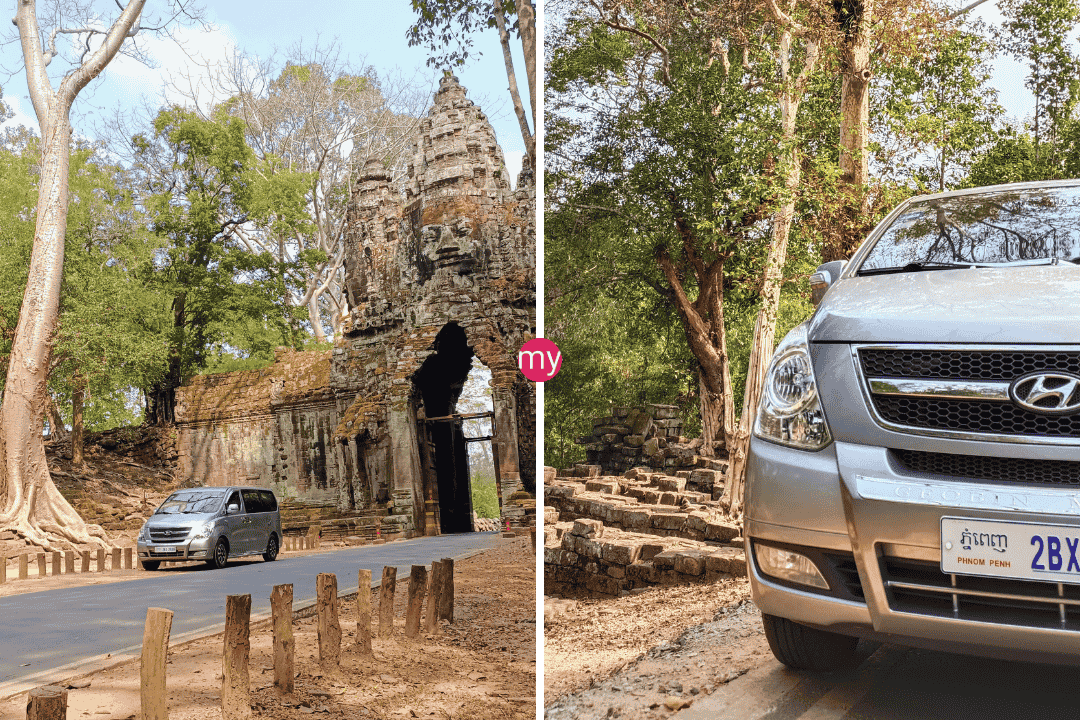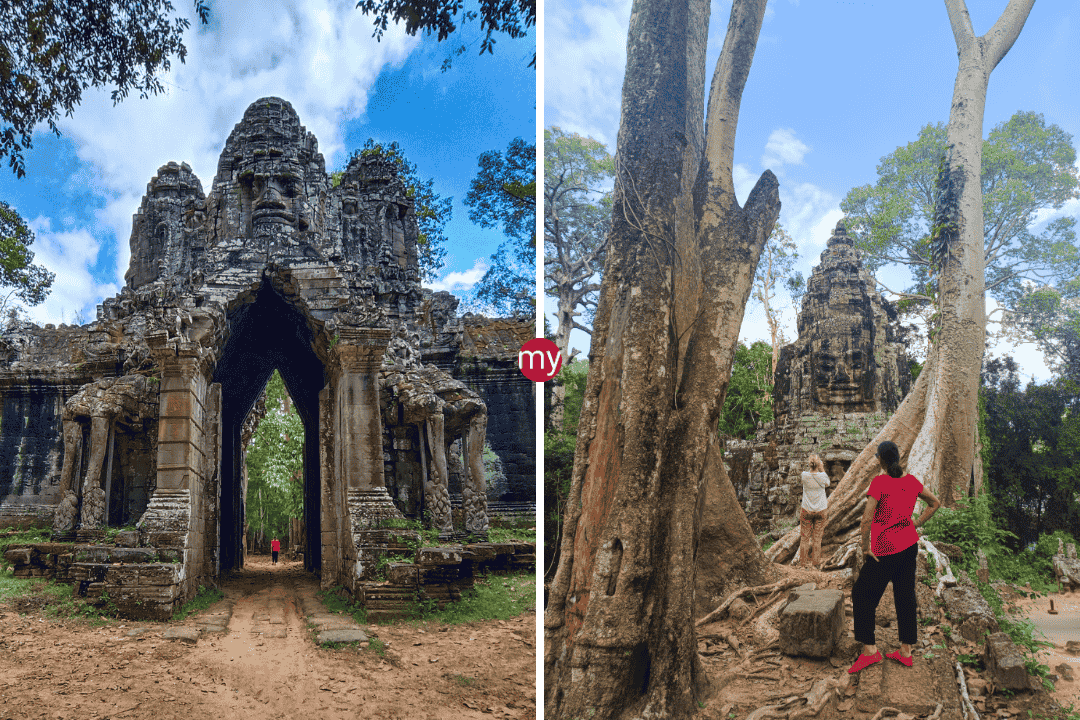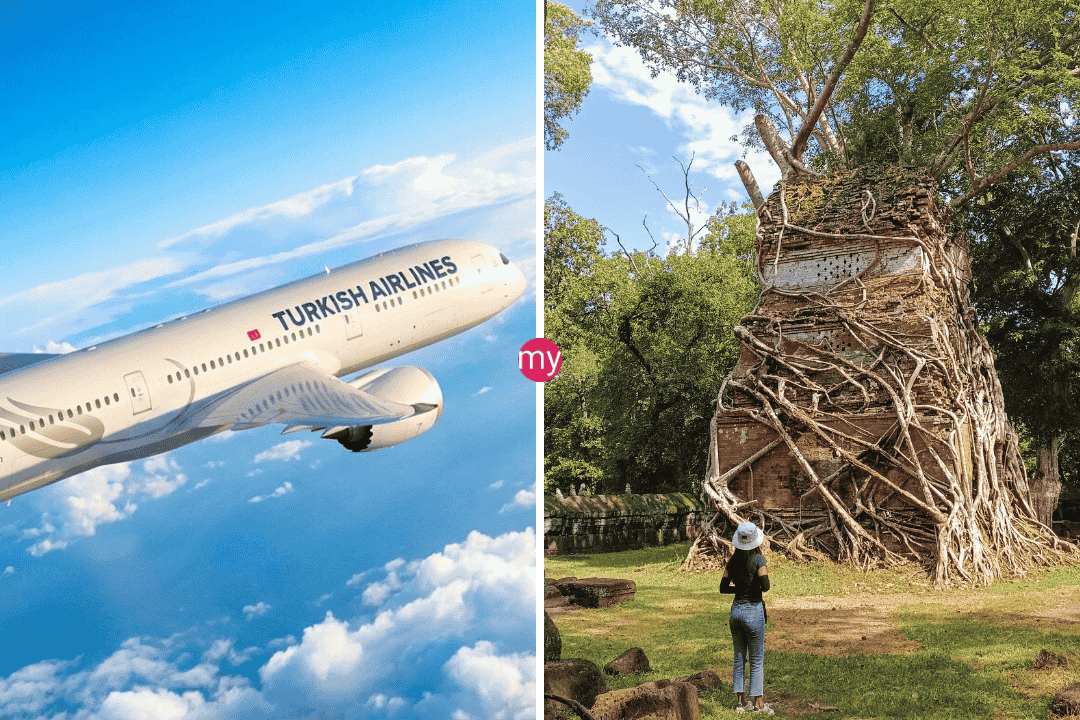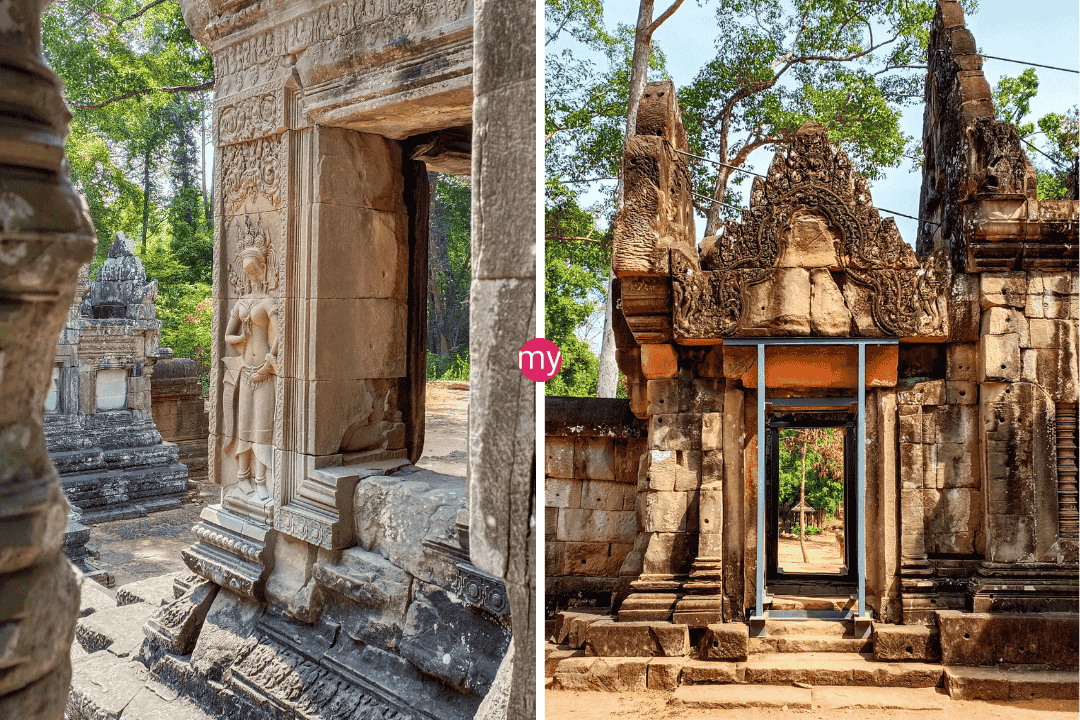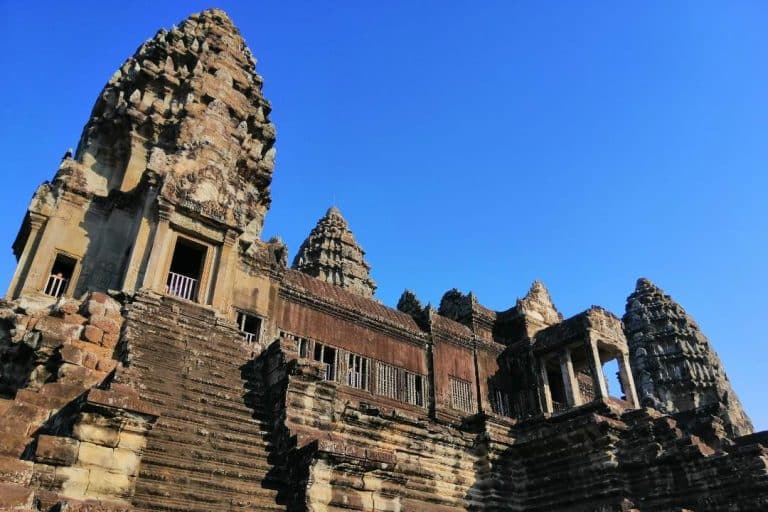
Angkor Wat: The Cosmic Temple - A Journey through Time and Space
Angkor Wat: The Cosmic Temple
The Foundations of Angkor Wat: History and Mythology
This article delves into the enigmatic world of Angkor Wat, Cambodia’s largest and most famous temple complex. Built in the 12th century by the Khmer king Suryavarman II, Angkor Wat has captivated the minds and hearts of people for centuries. Its amazing architecture, intricate carvings, and mysteries about how it was built make it interesting to historians, archaeologists, and tourists alike.
In this article, we’ll talk about where Angkor Wat came from in the sky, looking at how astronomy and mythology played a part in building the temple.
We will look at the building methods and new ideas that made it possible to build such a huge building, as well as the gods who were worshipped inside its walls.
As we journey through the mythological landscape of Angkor Wat, we will uncover the stories and legends passed down through generations. In addition, we will delve into the temple’s astronomical significance, and explore how its layout reflects the heavens above.
By understanding how cosmic harmony was used in the building of Angkor Wat, we can understand how spiritual and knowledgeable the ancient Khmer people were.
The rise and fall of Angkor Wat will also be discussed, providing insights into the fate of this once-great civilization and the reasons behind its decline. Finally, as we explore the modern perspectives on Angkor Wat, we will see how the temple continues to inspire people today, and how new discoveries are shedding light on its enduring legacy.
“Mysteries of the Stars: Angkor Wat, The Cosmic Temple and Its Mythological Legacy” promises to be a captivating journey into the heart of this ancient temple, revealing the secrets and stories that have been hidden within its walls for centuries.
So, embark on this adventure with us as we unlock the mysteries of Angkor Wat, and uncover the cosmic connections that bind it to the heavens above.
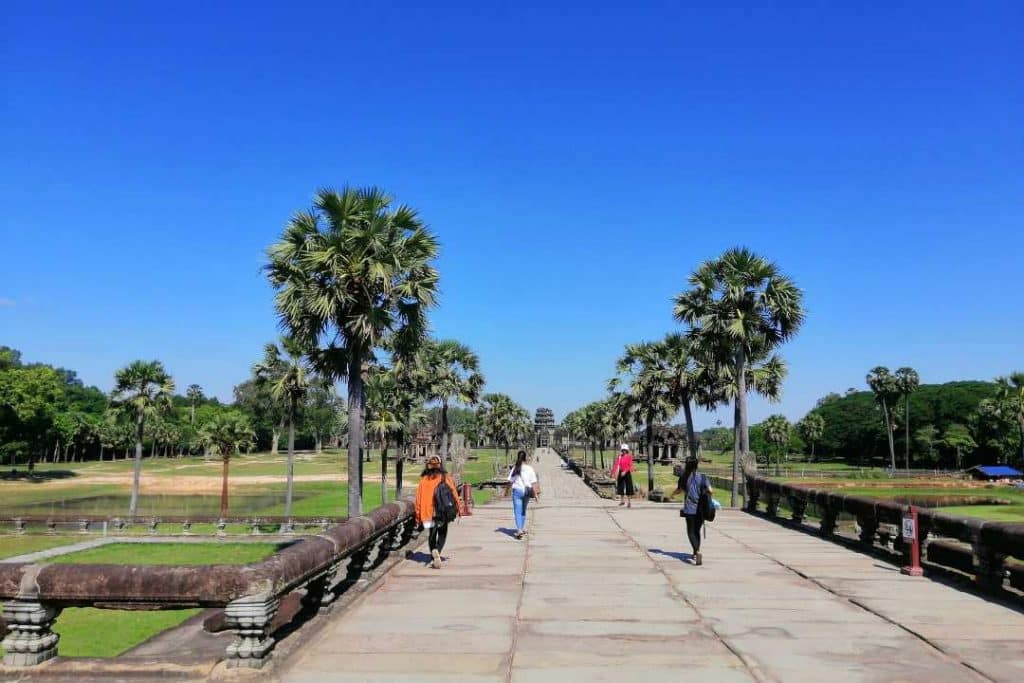
The Celestial Origins of Angkor Wat
The majestic temple of Angkor Wat is a testament to the ingenuity and spiritual depth of the ancient Khmer civilization. As we delve into the celestial origins of this awe-inspiring temple, it is essential to understand the role astronomy and mythology played in its design and construction.
Angkor Wat, which means “City of Temples” in the Khmer language, was built during the reign of King Suryavarman II in the first half of the 12th century. It was initially dedicated to the Hindu god Vishnu, and later, it became a center of Buddhist worship.
The temple’s layout and design are deeply rooted in Hindu cosmology, particularly the concept of Mount Meru. This mythical five-peaked mountain serves as the axis of the universe in Hindu, Jain, and Buddhist cosmology.
Angkor Wat is a symbolic representation of Mount Meru, with its central tower representing the mountain’s peak and the concentric galleries simulating the mountain ranges and oceans surrounding it.
Astronomy played a significant role in ancient Khmer culture, as it did in many other civilizations throughout history. The celestial bodies served as a guide for agricultural practices, timekeeping, and religious rituals. So, unsurprisingly, the architects of Angkor Wat incorporated astronomical alignments into the temple’s design.
One notable example of astronomical alignment at Angkor Wat is the temple’s orientation toward the west, which is unusual for Hindu temples. This orientation signifies the association of the temple with the setting sun and the afterlife.
On the equinoxes, the sun sets directly behind the central tower of Angkor Wat, creating a spectacular visual effect. It is a famous spectacular view during our Full Day Angkor Wat Sunrise tour.
The temple’s western orientation also aligns with the Hindu belief that the god Vishnu, to whom the temple was initially dedicated, resided in the west.
Another fascinating celestial alignment in Angkor Wat is the connection between the temple and the constellation Draco. Scholars have found that during the temple’s construction in the 12th century, the constellation Draco was directly above Angkor Wat at the time of the equinoxes.
This alignment might have held symbolic significance for the Khmer people and contributed to the temple’s sacred status.
The influence of Hindu mythology on the design and construction of Angkor Wat extends beyond celestial alignments and cosmological symbolism. The temple’s walls are adorned with intricate bas-reliefs depicting scenes from Hindu epics, such as the Ramayana and the Mahabharata.
These epics are imbued with celestial themes, as various gods and divine beings play significant roles in the narratives. Including these stories in the temple’s artwork further emphasizes the deep connection between Angkor Wat and the celestial realm.
In conclusion, the celestial origins of Angkor Wat are apparent in the temple’s design, layout, and artwork, which are deeply rooted in Hindu cosmology and astronomy.
The temple’s architects masterfully integrated celestial alignments and mythological symbolism to create a sacred space that mirrors the cosmos, honoring the gods and reflecting the ancient Khmer civilization’s profound understanding of the universe.
Moving through the chapters, we will learn more about how Angkor Wat is connected to the heavens. This will show us the temple’s fascinating history and lasting legacy.
The Architectural Marvel: Engineering a Cosmic Temple
Angkor Wat stands as an architectural marvel of the ancient world. The temple’s construction required remarkable skill, ingenuity, and advanced engineering techniques that continue to captivate historians, architects, and tourists alike.
In this chapter, we will analyze the architectural techniques and innovations that allowed the construction of Angkor Wat, detail the temple’s intricate carvings and bas-reliefs, and explore the role of water in the temple’s design and spiritual significance.
One of the most notable aspects of Angkor Wat’s construction is the extensive use of sandstone blocks, which were quarried from the nearby Kulen Mountains. The builders transported these massive blocks, some weighing several tons, to the construction site using a complex system of canals and wooden rollers.
- The precision and craftsmanship with which the blocks were cut and assembled allowed for a tight fit, often eliminating the need for mortar.
- The intricate carvings on the blocks were created using a combination of hard and soft hammering techniques, allowing for precise and delicate detailing.
The temple’s layout and structural design reflect the concept of the cosmic temple.
Angkor Wat consists of a series of concentric rectangular galleries, with each level rising above the previous one, culminating in the central sanctuary, which is surrounded by five soaring towers.
These towers symbolize Mount Meru’s five peaks, reinforcing the temple’s connection to Hindu cosmology. The temple’s axial alignment and the harmony of its proportions also contribute to the sense of cosmic order and balance.
Angkor Wat’s walls and galleries are adorned with intricate carvings and bas-reliefs that depict Hindu mythology scenes, historical events, and daily life in the Khmer Empire.
One of the most famous bas-reliefs is the Churning of the Ocean of Milk, which illustrates a mythological event involving gods and demons churning the cosmic ocean to obtain the elixir of immortality. This scene, among others, highlights the temple’s connection to the celestial realm and reinforces its sacred status.
Water plays a crucial role in Angkor Wat’s design and spiritual significance.
The temple is surrounded by a vast moat, which represents the cosmic ocean surrounding Mount Meru.
- The moat also served practical purposes, such as providing a source of water for daily use, maintaining structural stability by reducing soil erosion, and acting as a defensive barrier against potential invaders.
- Within the temple complex, a network of canals, ponds, and reservoirs facilitated the flow of water, which was essential for rituals and ceremonies.
In addition to its symbolic and practical functions, water was crucial to the temple’s spiritual significance. The act of crossing the moat to enter the temple symbolized the transition from the mundane world to the sacred realm.
The causeway leading to the temple’s main entrance is lined with balustrades in the form of serpents, known as nagas, which are believed to be guardians of water and are often associated with fertility and abundance in Hindu and Buddhist mythology.
In conclusion, the architectural techniques and innovations that allowed the construction of Angkor Wat are a testament to the ingenuity and craftsmanship of the ancient Khmer civilization.
The temple’s intricate carvings and bas-reliefs, along with the significant role of water in its design and spiritual significance, contribute to the temple’s status as a cosmic temple that mirrors the cosmos and serves as a bridge between the earthly and celestial realms.
As we continue our exploration of Angkor Wat, we will delve further into the fascinating myths and deities that inhabit this sacred space, shedding light on its enduring legacy and spiritual power.
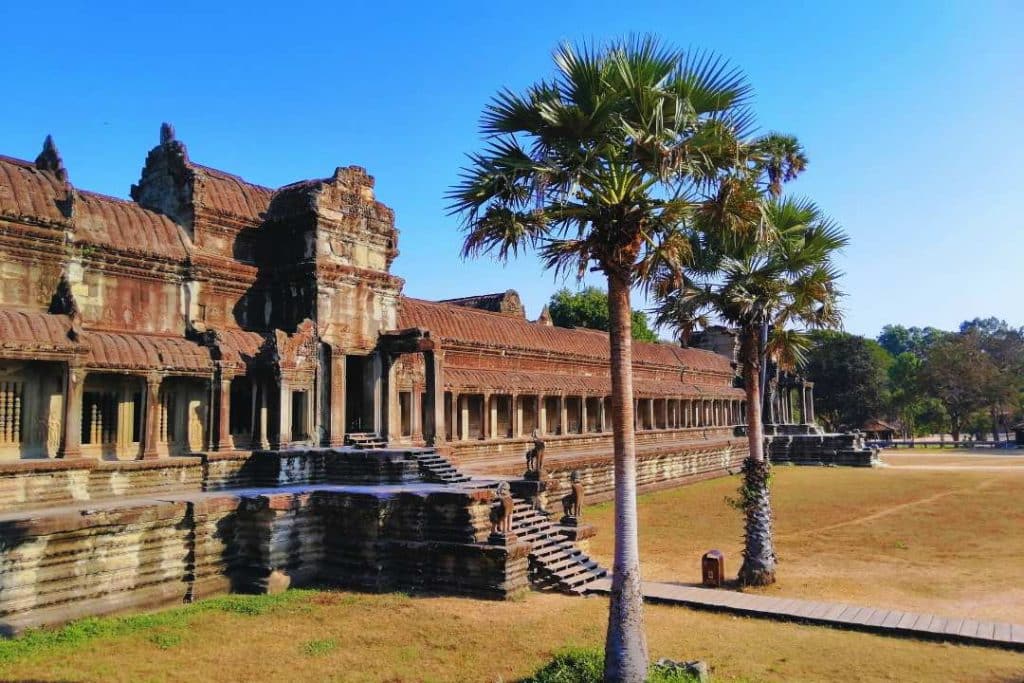
The Divine Assemblage: Deities of Angkor Wat
The sacred halls of Angkor Wat are home to a multitude of deities from the Hindu pantheon. These divine beings, immortalized in stone and art, played crucial roles in the spiritual life of the Khmer civilization. In this chapter, we will describe the various deities worshiped within the temple, highlighting their individual roles and significance.
Vishnu: Angkor Wat was initially dedicated to the Hindu god Vishnu, one of the principal deities in the Hindu trinity (Trimurti) alongside Brahma and Shiva.
“Known as the Preserver, Vishnu is responsible for the maintenance of the cosmic order and the protection of the universe. His association with Angkor Wat is symbolized by the temple’s western orientation, as Vishnu was believed to reside in the western direction. Within the temple, several sculptures and bas-reliefs depict Vishnu in his various incarnations, known as avatars, which include Rama and Krishna.”
Shiva: Another prominent deity worshiped at Angkor Wat is Shiva, the Destroyer and Transformer within the Hindu trinity.
“Shiva is associated with both destruction and regeneration, symbolizing the cyclical nature of the universe. In the temple, Shiva is often shown as a lingam, a cylinder-shaped stone that stands for the cosmic pillar that connects the earth to the heavens. The presence of Shiva at Angkor Wat reflects the syncretic nature of Khmer religious practices, as the temple complex integrates elements of both Vishnu and Shiva worship.”
Brahma: The third deity in the Hindu trinity, Brahma, is the Creator of the universe.
“Although less prominently represented in the temple’s artwork, Brahma can be found in a few bas-reliefs and sculptures. Typically depicted with four heads and four arms, Brahma symbolizes the cosmic mind and the creative force that brings the universe into existence.”
Asuras and Devas: In Hindu mythology, the epic battles between the asuras (demons) and the devas (gods) are a recurring theme. The bas-reliefs at Angkor Wat show these battles in great detail.
“Each of these celestial beings has its own powers and traits, and they are often shown fighting. This shows the eternal battle between good and evil. The Churning of the Ocean of Milk, one of the temple’s most famous bas-reliefs, captures the tension between these opposing forces as they work together to obtain the elixir of immortality.”
Apsaras and Devatas: Apsaras and Devatas are celestial nymphs that decorate the walls of Angkor Wat. Their graceful bodies and calm faces show how good Khmer sculptors were at making art.
“Apsaras are celestial dancers and musicians who entertain the gods, while devatas are guardian spirits associated with natural elements and sacred spaces. These divine beings are integral to the spiritual ambiance of the temple, serving as intermediaries between the human and divine realms.”
Over time, Angkor Wat transitioned from a predominantly Hindu temple to a center of Buddhist worship. As a result, several Buddhist deities and iconography, such as the Buddha and bodhisattvas, have also found a place within the temple complex.
This mixing of Hinduism and Buddhism in the temple’s religious practices and art is unique to Angkor Wat and shows how flexible and adaptable Khmer religion is.
In conclusion, the divine assembly of deities that can be found at Angkor Wat symbolizes the rich tapestry of religious rituals and beliefs that are associated with the Khmer people.
These heavenly beings have been preserved forever in the temple by means of its exquisite sculptures and bas-reliefs, which offer a look into the religious practices of the ancient Khmer civilisation.
We will delve deeper into the myths and legends that surround these deities and the temple itself as we continue our investigation into the mysteries of Angkor Wat in the following chapters. We will also look into how the design and construction of the temple reflect the harmony of the universe as a whole.

Gods and Kings at Angkor Wat: The Royal Patronage of the Devaraja Cult
The majestic temple complex in Cambodia known as Angkor Wat has long represented the mighty and mysterious Khmer Empire. The Devaraja Cult, which united political and religious authority under the rule of the god-kings, played a crucial role in the growth of this kingdom.
The Devaraja Cult’s origins, beliefs, role in the royal patronage of Angkor Wat, the gods worshipped there, and daily life in the Khmer Empire will all be covered in this article. The Devaraja Cult’s demise and its enduring legacy will be covered last.
The Cult of Devaraja
Background and History
Throughout the ninth century, the Devaraja Cult, often known as the “god-king” cult, emerged as a major political and religious force in the Angkor Empire.
The rulers assumed divine status as embodiments of Hindu gods, and the religion developed as a result of the blending of Hinduism with local beliefs. As a result of their perceived spiritual and earthly authority, the kings could keep a firm grasp on power.
Principal Beliefs and Methods
The idea that the king was an embodiment of a Hindu deity, typically Vishnu or Shiva, was central to the Devaraja Cult. The king, a heavenly monarch, was charged with upholding cosmic harmony and safeguarding the welfare of his subjects.
Due to this religious system, the grand temples were constructed to commemorate the gods and the deified kings, with Angkor Wat serving as the most notable example.
Royal support for Angkor Wat
Expansion and Construction
Once a Hindu temple devoted to Vishnu, Angkor Wat was constructed in the 12th century under the rule of King Suryavarman II.
The king’s efforts to solidify his divine reign and increase his power included it.
As new kings rose to power over time, they added new structures to the temple complex and altered existing ones to suit their personal ideologies.
Impact on art and architecture
The Devaraja Cult had a profound influence on the design and artwork of Angkor Wat.
Hindu cosmology had a significant effect on the temple’s architecture, and the central tower represented Mount Meru, the fabled location of the gods.
The complex’s sculptures and bas-reliefs also feature scenes from Hindu mythology and representations of the king’s heavenly rank and military prowess.
Gods at Angkor Wat
Vishnu
One of the main gods venerated in Angkor Wat was Vishnu, the guardian and preserver of the cosmos.
The temple was originally devoted to Vishnu as a sign of his importance, and there are several representations of him throughout the complex.
A large statue of Vishnu is prominently displayed in the main shrine, underscoring the importance of the god to the Devaraja Cult.
Shiva
Shiva, the destroyer and regenerator was a key deity in the Khmer Kingdom.
Even while Vishnu was initially worshipped at Angkor Wat, many later rulers were Shiva believers. Because of this, the temple complex includes several shrines and sculptures devoted to this potent god, illuminating the god-kings’ evolving theological preferences.
Sacred Kings
The kings themselves were revered as gods, with some monarchs regarded as Vishnu or Shiva incarnations.
Building temples and other structures in their honor, with Angkor Wat as a notable example, further emphasized their supernatural status.
The temple’s galleries and walls portray the monarchs as godlike characters, with scenes of their military triumphs and achievements in the background.
Unraveling the Angkor Wat Mythology
Myths and legends about Angkor Wat make up a rich tapestry that weaves together the world of the gods and the world of humans. These stories show what the Khmer people believed and how they lived.
Let’s look at the myths and legends about the temple and how it was built. We’ll talk about the stories of the gods and how they fit into the history of the temple. We’ll also look at how these myths shaped the beliefs and culture of the Khmer people.
One of the most enduring myths surrounding Angkor Wat is the legend of its divine origin.
According to this legend, the temple was not built by human hands but instead descended from the heavens as a gift from the gods.
This belief is reinforced by the temple’s awe-inspiring architecture and celestial symbolism, which evoke a sense of otherworldly beauty and sacredness.
The divine origin myth also serves to emphasize the temple’s role as a bridge between the earthly and celestial realms, allowing the Khmer people to connect with the gods and seek their blessings.
The temple’s intricate bas-reliefs and carvings immortalize the stories of the gods and their cosmic exploits, providing valuable insights into the spiritual and cultural fabric of the Khmer civilization.
One such example is the Churning of the Ocean of Milk, a mythological event that symbolizes the cosmic struggle between the asuras (demons) and devas (gods).
The churning of the ocean results in the emergence of several divine treasures, including the elixir of immortality, which grants eternal life to those who consume it. This story serves as a metaphor for the eternal battle between good and evil, highlighting the importance of maintaining cosmic balance and harmony.
Another prominent mythological theme in Angkor Wat is the Ramayana, an ancient Indian epic that recounts the story of Prince Rama, an incarnation of the god Vishnu. Rama’s quest to rescue his wife, Sita, who has been kidnapped by the demon king Ravana, is a tale of love, loyalty, and perseverance. The Ramayana’s presence in the temple’s artwork not only reinforces Angkor Wat’s association with Vishnu but also serves as a reminder of the virtues and moral values that the Khmer civilization held in high esteem.
Similarly, scenes from the Mahabharata, another ancient Indian epic, adorn the temple’s walls. This epic tells the story of the Pandavas and the Kauravas, two sets of royal cousins who engage in a cataclysmic battle for the throne of Hastinapura. The Mahabharata explores themes of duty, righteousness, and the complexities of human relationships, offering moral guidance and philosophical insights that were central to the Khmer civilization’s belief system.
The myths and legends that surround Angkor Wat played a significant role in shaping the Khmer civilization’s beliefs and culture.
These stories served as a source of spiritual inspiration and moral guidance, fostering a deep connection between the people and the celestial realm. They also made the temple even more holy, making it a living symbol of the order and harmony that the Khmer people wanted to keep in the universe.
Unraveling the mythology of Angkor Wat offers a fascinating glimpse into the spiritual world of the ancient Khmer civilization. The temple’s intricate carvings and bas-reliefs tell the stories of gods and heroes, immortalizing the cosmic struggles and moral dilemmas that lie at the heart of human existence.
As we continue our journey through the temple’s history and its enduring legacy, we will further explore the impact of these myths on the cultural and artistic achievements of the Khmer civilization, as well as their relevance in the contemporary world.
The Astronomical Significance of Angkor Wat
The celestial symbolism and alignment of Angkor Wat reveal the ancient Khmer civilization’s profound understanding of astronomy and its importance in their culture.
It is about time to investigate the temple’s alignment with celestial bodies and events, explain the importance of astronomy in ancient Khmer culture, and discuss the ways Angkor Wat’s design reflects the cosmos.
Angkor Wat’s precise orientation and alignment with celestial bodies are evidence of the temple’s astronomical significance.
The temple is oriented to the west, a direction associated with the Hindu god Vishnu, to whom the temple was originally dedicated. This alignment has a critical astronomical implication: during the spring and autumn equinoxes, the sun rises directly above the temple’s central tower, casting a symmetrical shadow on the ground below. This phenomenon highlights the temple’s role as a cosmic temple, designed to mirror the harmony and balance of the universe.
Its connection to the lunar cycle further demonstrates the temple’s alignment with celestial events. Angkor Wat’s central axis aligns with the moon’s northernmost rising and setting points, linking the temple’s architecture to the movements of celestial bodies. This connection between the temple and the lunar cycle reflects the ancient Khmer civilization’s understanding of the cosmos and its influence on earthly events, such as the changing of the seasons and the rhythms of agricultural life.
Astronomy played a vital role in ancient Khmer culture, serving as a foundation for religious beliefs, calendrical systems, and agricultural practices.
The Khmer people believed that the movements of celestial bodies influenced the balance of cosmic forces, which in turn affected the natural world and human affairs.
Understanding the patterns and cycles of the celestial realm allowed the Khmer civilization to develop accurate calendars and predict important events, such as eclipses and solstices. These astronomical insights were also essential for determining auspicious dates for religious ceremonies, royal coronations, and other significant events.
Angkor Wat’s design reflects the cosmos in several ways, exemplifying the Khmer civilization’s integration of astronomy and religious beliefs.
The temple’s layout, with its concentric galleries and rising central sanctuary, symbolizes the Hindu concept of the cosmic mountain, Mount Meru, which is believed to be the center of the universe. The five central towers of Angkor Wat represent the five peaks of Mount Meru, while the vast moat that surrounds the temple symbolizes the cosmic ocean.
The temple’s intricate carvings and bas-reliefs also incorporate celestial imagery, illustrating the deep connection between the earthly and cosmic realms. Scenes from Hindu mythology, such as the Churning of the Ocean of Milk, depict celestial beings and events that mirror the cosmic struggle between order and chaos.
The presence of celestial nymphs, such as apsaras and devatas, further underscores the temple’s connection to the celestial realm.
In conclusion, the astronomical significance of Angkor Wat is a testament to the ancient Khmer civilization’s sophisticated understanding of the cosmos and its integration with their culture and religious beliefs.
The temple’s alignment with celestial bodies and events, as well as its design and artwork, serve as a bridge between the earthly and celestial realms, reflecting the harmony and balance of the universe.

The Fall of Angkor: Fate and Lost Knowledge
The decline of the Khmer Empire and the abandonment of Angkor Wat are complex events in the history of Southeast Asia that have left an indelible mark on the region’s cultural and architectural legacy.
The fall of the Khmer Empire can be attributed to a combination of factors, including environmental, political, and economic issues.
One of the most significant environmental factors was the gradual decline in the availability of water, which was essential for the empire’s extensive agricultural system.
The Angkor region experienced a series of prolonged droughts and unpredictable monsoons, which disrupted the empire’s intricate system of canals and reservoirs. This, in turn, led to reduced agricultural productivity and a decline in the empire’s economic stability.
Politically, the Khmer Empire faced growing pressure from neighboring kingdoms, particularly the Siamese (Thai) and the Cham.
The empire’s military was stretched thin as it attempted to defend its borders from external threats. Moreover, the burden of maintaining such a large and complex state began to take its toll on the empire’s resources.
The Siamese eventually captured Angkor in 1431, significantly declining the city’s importance as a political and religious center.
Economically, the Khmer Empire struggled to adapt to changing regional trade dynamics.
As maritime trade routes in the Indian Ocean and the South China Sea grew in importance, the empire’s inland location and reliance on overland trade routes left it increasingly isolated from the economic opportunities of the wider world.
This isolation further contributed to the empire’s wealth and power decline.
The abandonment of Angkor Wat is a subject of ongoing debate among scholars.
Some argue that the temple was never fully abandoned, as evidenced by the continued presence of Buddhist monks and small communities in the surrounding area.
Others contend that the temple was largely forgotten and left to the mercy of the encroaching jungle for centuries, only to be rediscovered and brought to international attention in the 19th century.
Regardless of the exact circumstances of the temple’s abandonment, the decline of the Khmer Empire and the shifting religious landscape of the region led to Angkor Wat’s diminished prominence as a center of worship and pilgrimage.
The abandonment of Angkor Wat positively and negatively impacted the temple’s preservation.
On the one hand, the temple’s isolation and disuse allowed it to escape the ravages of war and political upheaval that affected many other ancient structures in the region. On the other hand, the dense jungle that enveloped the temple also provided a measure of protection from the elements, helping to preserve many of its intricate carvings and bas-reliefs.
On the other hand, the temple’s abandonment left it vulnerable to the forces of nature and human encroachment. Over time, the jungle’s relentless growth caused significant damage to the temple’s walls and foundations while looters and treasure hunters plundered many of its precious artifacts.
The temple’s rediscovery and subsequent restoration efforts have helped to mitigate some of this damage, but the full extent of the lost knowledge and cultural heritage remains difficult to quantify.
In conclusion, the fall of the Khmer Empire and the abandonment of Angkor Wat are complex and multifaceted events that have left an enduring impact on the temple’s preservation and the region’s cultural legacy. Moreover, the factors contributing to the empire’s decline, including environmental, political, and economic issues, provide valuable insights into the challenges faced by ancient civilizations and the fragility of their achievements.
Featured
Recent Articles
Koh Ker vs Beng Mealea – Complete Comparison Guide for 2026 – Which Remote Temple to Visit? Or Visit Them Both?
New Budget International Flights to Siem Reap
Angkor Wat Small Circuit vs Grand Circuit – Complete Comparison Guide 2026
Turkish Airlines Launches Direct Service to Phnom Penh: Your Complete Guide to Cambodia’s New European Connection
Ta Prohm vs Bayon Temple: Which Angkor Icon Deserves Your Time?
Best Tours to Angkor Wat from Siem Reap in 2026 – What 2.7 Million Visitors Need to Know – Your Guide to Prices, Tips and Best Routes
Explore more on My Siem Reap Tours
Koh Ker and Beng Mealea guided tour | Banteay Srei temple tour semi-private guided tour | Angkor Wat Sunrise shared tour | Koh Ker and Beng Mealea guided tour | Morning Siem Reap floating village tour | Afternoon Siem Reap floating village tour | Private Angkor Wat special tour | Kulen Waterfall small group guided Tour | Private Angkor Wat mix temples photo tour
